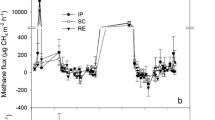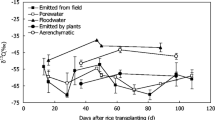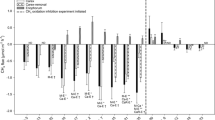Abstract
Aims
Poorly drained arctic ecosystems are potential large emitters of methane (CH4) due to their high soil organic carbon content and low oxygen availability. In wetlands, aerenchymatous plants transport CH4 from the soil to the atmosphere, but concurrently transport O2 to the rhizosphere, which may lead to oxidation of CH4. The importance of the latter process is largely unknown for arctic plant species and ecosystems. Here, we aim to quantify the subsurface oxidation of CH4 in a waterlogged arctic ecosystem dominated by Carex aquatilis ssp. stans and Eriophorum angustifolium, and evaluate the overall effect of these plants on the CH4 budget.
Methods
A mesocosms study was established based on the upper 20 cm of an organic soil profile with intact plants retrieved from a peatland in West Greenland (69°N). We measured dissolved concentrations and emissions of 13CO2 and 13CH4 from mesocosms during three weeks after addition of 13C-enriched CH4 below the mesocosm.
Results
Most of the recovered 13C label (>98 %) escaped the ecosystem as CH4, while less than 2 % was oxidized to 13CO2.
Conclusions
It is concluded that aerenchymatous plants control the overall CH4 emissions but, as a transport system for oxygen, are too inefficient to markedly reduce CH4 emissions.





Similar content being viewed by others
References
Armstrong J, Armstrong W (1988) Phragmites australis - a preliminary study of soil-oxidizing sites and internal gas transport pathways. New Phytol 108:373–382. doi:10.1111/j.1469-8137.1988.tb04177.x
Askaer L, Elberling B, Glud RN, Kuhl M, Lauritsen FR, Joensen HR (2010) Soil heterogeneity effects on O2 distribution and CH4 emissions from wetlands: In situ and mesocosm studies with planar O2 optodes and membrane inlet mass spectrometry. Soil Biol Biochem 42:2254–2265. doi:10.1016/j.soilbio.2010.08.026
Beal EJ, Claire MW, House CH (2011) High rates of anaerobic methanotrophy at low sulfate concentrations with implications for past and present methane levels. Geobiology 9:131–139. doi:10.1111/j.1472-4669.2010.00267.x
Calhoun A, King GM (1997) Regulation of root-associated methanotrophy by oxygen availability in the rhizosphere of two aquatic macrophytes. Appl Environ Microbiol 63:3051–3058
Christiansen J, Romero A, Jørgensen NG, Glaring M, Jørgensen C, Berg L, Elberling B (2014) Methane fluxes and the functional groups of methanotrophs and methanogens in a young Arctic landscape on Disko Island, West Greenland. Biogeochemistry: 1–19. doi: 10.1007/s10533-014-0026-7
Collins M, Knutti R, Arblaster J, Dufresne J-L, Fichefet T, Friedlingstein P, Gao X, Gutowski WJ, Johns T, Krinner G, Shongwe M, Tebaldi C, Weaver AJ, Wehner M (2013) Long-term climate change: projections, commitments and irreversibility. In: Stocker TF, Qin D, Plattner G-K, Tignor M, Allen SK, Boschung J, Nauels A, Xia Y, Bex V, Midgley PM (eds) Climate change 2013: The physical science basis contribution of working group I to the fifth assessment report of the intergovernmental panel on climate change. Cambridge University Press, Cambridge, United Kingdom and New York, NY, USA
D’Imperio L, Nielsen CS, Westergaard-Nielsen A, Michelsen A, Elberling B (2016) Methane oxidation in contrasting soil types: responses to experimental warming with implication for landscape-integrated CH4 budget. Glob Chang Biol. doi:10.1111/gcb.13400
Ding WX, Cai ZC, Tsuruta H (2004) Summertime variation of methane oxidation in the rhizosphere of a Carex dominated freshwater marsh. Atmos Environ 38:4165–4173. doi:10.1016/j.atmosenv.2004.04.022
Ding WX, Cai ZC, Tsuruta H (2005) Factors affecting seasonal variation of methane concentration in water in a freshwater marsh vegetated with Carex lasiocarpa. Biol Fertil Soils 41:1–8. doi:10.1007/s00374-004-0812-9
Elberling B, Nordstrøm C, Grøndahl L, Søgaard H, Friborg T, Christensen TR, Ström L, Marchand F, Nijs I (2008) High-arctic soil CO2 and CH4 production controlled by temperature, water, freezing and snow. In: Meltofte H, Christensen TR, Elberling B, Forchhammer MC, Rasch M (eds) Advances in ecological research, Vol 40: High-Arctic ecosystem dynamics in a changing climate. Elsevier Academic Press Inc, San Diego
Elberling B, Askaer L, Jørgensen CJ, Joensen HP, Kuhl M, Glud RN, Lauritsen FR (2011) Linking Soil O2, CO2, and CH4 Concentrations in a Wetland Soil: Implications for CO2 and CH4 Fluxes. Environ Sci Technol 45:3393–3399. doi:10.1021/es103540k
Frenzel P, Rudolph J (1998) Methane emission from a wetland plant: the role of CH4 oxidation in Eriophorum. Plant Soil 202:27–32. doi:10.1023/a:1004348929219
Gerard G, Chanton J (1993) Quantification of methane oxidation in the rhizosphere of emergent aquatic macrophytes: Defining upper limits. Biogeochemistry 23:79–97. doi:10.1007/Bf00000444
Groot TT, Bodegom PMV, Harren FJM, Meijer HAJ (2003) Quantification of methane oxidation in the rice rhizosphere using 13C-labelled methane. Biogeochemistry 64:355–372. doi:10.2307/1469748
Hartmann DL, Klein Tank AMG, Rusticucci M, Alexander LV, Brönnimann S, Charabi Y, Dentener FJ, Dlugokencky EJ, Easterling DR, Kaplan A, Soden BJ, Thorne PW, Wild M, Zhai PM (2013) Observations: atmosphere and surface. In: Stocker TF, Qin D, Plattner G-K, Tignor M, Allen SK, Boschung J, Nauels A, Xia Y, Bex V, Midgley PM (eds) Climate change 2013: The physical science basis contribution of working group I to the fifth assessment report of the intergovernmental panel on climate change. Cambridge University Press, Cambridge, United Kingdom and New York, NY, USA
Hollesen J, Buchwal A, Rachlewicz G, Hansen BU, Overgaard M, Stecher O, Elberling B (2015) Winter warming as an important co-driver for Betula nana growth in western Greenland during the past century. Glob Chang Biol 21:2410–2423
Johnston CE, Ewing SA, Harden JW, Varner RK, Wickland KP, Koch JC, Fuller CC, Manies K, Jorgenson MT (2014) Effect of permafrost thaw on CO2 and CH4 exchange in a western Alaska peatland chronosequence. Environ Res Lett 9. doi:10.1088/1748-9326/9/8/085004
Jonasson S, Michelsen A, Schmidt IK, Nielsen EV, Callaghan TV (1996) Microbial biomass C, N and P in two arctic soils and responses to addition of NPK fertilizer and sugar: Implications for plant nutrient uptake. Oecologia 106:507–515. doi:10.1007/bf00329709
Kankaala P, Bergström I (2004) Emission and oxidation of methane in Equisetum fluviatile stands growing on organic sediment and sand bottoms. Biogeochemistry 67:21–37. doi:10.1023/b:biog.0000015277.17288.7a
King GM (1996) In situ analyses of methane oxidation associated with the roots and rhizomes of a bur reed, Sparganium eurycarpum, in a Maine wetland. Appl Environ Microbiol 62:4548–4555
King JY, King JY, Reeburgh WS, Reeburgh WS, Regli SK, Regli SK (1998) Methane emission and transport by arctic sedges in Alaska: Results of a vegetation removal experiment
Klapstein SJ, Turetsky MR, Mcguire AD, Harden JW, Czimczik CI, Xu XM, Chanton JP, Waddington JM (2014) Controls on methane released through ebullition in peatlands affected by permafrost degradation. J Geophys Res Biogeosci 119:418–431
Kutzbach L, Wagner D, Pfeiffer EM (2004) Effect of microrelief and vegetation on methane emission from wet polygonal tundra, Lena Delta, Northern Siberia. Biogeochemistry 69:341–362. doi:10.1023/B:BIOG.0000031053.81520.db
Laanbroek HJ (2010) Methane emission from natural wetlands: interplay between emergent macrophytes and soil microbial processes. A mini-review. Ann Bot 105:141–153. doi:10.1093/aob/mcp201
Lichtfouse E, Lichtfouse M, Jaffrézic A (2003) δ13C values of grasses as a novel indicator of pollution by fossil-fuel-derived greenhouse Gas CO2 in urban areas. Environ Sci Technol 37(1):87–89
Lombardi JE, Epp MA, Chanton JP (1997) Investigation of the methyl fluoride technique for determining rhizospheric methane oxidation. Biogeochemistry 36:153–172. doi:10.1023/a:1005750201264
Michelsen A, Graglia E, Schmidt IK, Jonasson S, Sleep D, Quarmby C (1999) Differential responses of grass and a dwarf shrub to long-term changes in soil microbial biomass C, N and P following factorial addition of NPK fertilizer, fungicide and labile carbon to a heath. New Phytol 143:523–538. doi:10.1046/j.1469-8137.1999.00479.x
Moosavi SC, Crill PM (1998) CH4 oxidation by tundra wetlands as measured by a selective inhibitor technique. J Geophys Res-Atmos 103:29093–29106. doi:10.1029/97jd03519
Norði K, Thamdrup B (2014) Nitrate-dependent anaerobic methane oxidation in a freshwater sediment. Geochim Cosmochim Acta 132:141–150. doi:10.1016/j.gca.2014.01.032
Olefeldt D, Turetsky MR, Crill PM, McGuire AD (2013) Environmental and physical controls on northern terrestrial methane emissions across permafrost zones. Glob Chang Biol 19:589–603. doi:10.1111/gcb.12071
Popp TJ, Chanton JP, Whiting GJ, Grant N (1999) Methane stable isotope distribution at a Carex dominated fen in north central Alberta. Glob Biogeochem Cycles 13:1063–1077. doi:10.1029/1999gb900060
Popp TJ, Chanton JP, Whiting GJ, Grant N (2000) Evaluation of methane oxidation in the rhizosphere of a Carex dominated fen in north central Alberta, Canada. Biogeochemistry 51:259–281. doi:10.1023/a:1006452609284
Preuss I, Knoblauch C, Gebert J, Pfeiffer EM (2013) Improved quantification of microbial CH4 oxidation efficiency in arctic wetland soils using carbon isotope fractionation. Biogeosciences 10:2539–2552. doi:10.5194/bg-10-2539-2013
Saarnio S, Alm J, Silvola J, Lohila A, Nykanen H, Martikainen PJ (1997) Seasonal variation in CH4 emissions and production and oxidation potentials at microsites on an oligotrophic pine fen. Oecologia 110:414–422. doi:10.1007/s004420050176
Schimel JP (1995) Plant-transport and methane production as controls on methane flux from arctic wet meadow tundra. Biogeochemistry 28:183–200. doi:10.1007/Bf02186458
Schuur EAG, McGuire AD, Schädel C, Grosse G, Harden JW, Hayes DJ, Hugelius G, Koven CD, Kuhry P, Lawrence DM, Natali SM, Olefeldt D, Romanovsky VE, Schaefer K, Turetsky MR, Treat CC, Vonk JE (2015) Climate change and the permafrost carbon feedback. Nature 520(7546):171–179
Segers R (1998) Methane production and methane consumption: a review of processes underlying wetland methane fluxes. Biogeochemistry 41:23–51. doi:10.1023/a:1005929032764
Shaver GR, Billings WD (1977) Effects of daylength and temperature on root elongation in tundra graminoids. Oecologia 28:57–65. doi:10.1007/BF00346836
Ström L, Mastepanov M, Christensen TR (2005) Species-specific effects of vascular plants on carbon turnover and methane emissions from wetlands. Biogeochemistry 75:65–82. doi:10.1007/s10533-004-6124-1
Ström L, Tagesson T, Mastepanov M, Christensen TR (2012) Presence of Eriophorum scheuchzeri enhances substrate availability and methane emission in an Arctic wetland. Soil Biol Biochem 45:61–70. doi:10.1016/j.soilbio.2011.09.005
Tagesson T, Molder M, Mastepanov M, Sigsgaard C, Tamstorf MP, Lund M, Falk JM, Lindroth A, Christensen TR, Strom L (2012) Land-atmosphere exchange of methane from soil thawing to soil freezing in a high-Arctic wet tundra ecosystem. Glob Chang Biol 18:1928–1940. doi:10.1111/j.1365-2486.2012.02647.x
Turetsky MR, Treat CC, Waldrop MP, Waddington JM, Harden JW, McGuire AD (2008) Short-term response of methane fluxes and methanogen activity to water table and soil warming manipulations in an Alaskan peatland. J Geophys Res-Biogeosci 113:15. doi:10.1029/2007jg000496
van der Nat F, Middelburg JJ (1998) Seasonal variation in methane oxidation by the rhizosphere of Phragmites australis and Scirpus lacustris. Aquat Bot 61:95–110. doi:10.1016/s0304-3770(98)00072-2
Visser EJW, Colmer TD, Blom C, Voesenek L (2000) Changes in growth, porosity, and radial oxygen loss from adventitious roots of selected mono- and dicotyledonous wetland species with contrasting types of aerenchyma. Plant Cell Environ 23:1237–1245
Acknowledgments
The Danish National Research Foundation is gratefully acknowledged for the funding of this study through the funding of CENPERM (DNRF100). We thank Frida Lindwall and Nynne Rand Ravn for peat block collection and transport to Copenhagen, Katrine Wulff for help during the incubation experiments, and technicians at CENPERM for help with analyses.
Author information
Authors and Affiliations
Corresponding author
Additional information
Responsible Editor: Paul Bodelier.
Electronic supplementary material
Below is the link to the electronic supplementary material.
Fig. S1
Redox measurement on mesocosm soil. The dashed line represents approximately the soil surface. Data points are averages and error bars show standard error (GIF 11 kb)
Fig. S2
Ecosystem fluxes of a) CH4 (μmol m−2 h−1) and b) CO2 (mmol m−2 h−1). Grey legend filling indicate data from the intensively monitored mesocosm, and black legend filling indicate average data of three replicate mesocosms. Error bars show standard error (GIF 16 kb)
Fig. S3
Plant fluxes (μmol plant−1 h−1) of a) CH4 and b) CO2. Grey legend filling indicate data from the intensively monitored mesocosm, and black legend filling indicate average data of three replicate mesocosms. Error bars show standard error (GIF 24 kb)
Fig S4
Fluxes of CH4 and CO2 (μmol plant−1 h−1) from the small Carex shoot (GIF 10 kb)
Fig. S5
a) Carbon isotope composition of dissolved CH4 (atom% 13C) and b) dissolved CO2 (δ13C ‰) in the soil water in six depths (down to 18 cm). Data points are averages and error bars show standard error (GIF 26 kb)
Fig S6
Carbon isotope composition (δ13C ‰) of a) CH4 and b) CO2 emitted from whole mesocosms ecosystem and plants. Data points without error bars are values from the intensively monitored replicate. Data points with error bars are averages of the three replicates. Error bars show standard error (GIF 23 kb)
Fig S7
Carbon isotope composition (δ13C ‰) of CH4 and CO2 emitted from the small Carex shoot (GIF 14 kb)
Fig. S8
Cumulated fluxes of excess 13C as CH4 (μg g−1 roots) from the mesocosms. Grey legend filling indicate data from the intensively monitored mesocosm, and black legend filling indicate average data of three replicate mesocosms. Error bars show standard error (GIF 5 kb)
Fig. S9
Carbon isotope composition (δ13C ‰) of CH4 at 261 h after labeling plotted against soil depth. The curve shows a logarithmic regression. Data points are averages and error bars show standard error (GIF 8 kb)
Rights and permissions
About this article
Cite this article
Nielsen, C.S., Michelsen, A., Ambus, P. et al. Linking rhizospheric CH4 oxidation and net CH4 emissions in an arctic wetland based on 13CH4 labeling of mesocosms. Plant Soil 412, 201–213 (2017). https://doi.org/10.1007/s11104-016-3061-4
Received:
Accepted:
Published:
Issue Date:
DOI: https://doi.org/10.1007/s11104-016-3061-4




